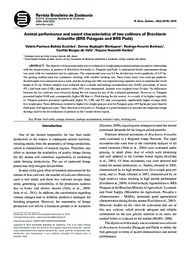Animal performance and sward characteristics of two cultivars of Brachiaria brizantha (BRS Paiaguás and BRS Piatã).
Animal performance and sward characteristics of two cultivars of Brachiaria brizantha (BRS Paiaguás and BRS Piatã).
Autoria: EUCLIDES, V. P. B.; MONTAGNER, D. B.; BARBOSA, R. A.; VALLE, C. B. do; NANTES, N. N.
Resumo: The objective of the present study was to evaluate live weight gain per animal and per area and its relationship with the characteristics of pastures of Brachiaria brizantha cv. Paiaguás and Piatã. A randomized blocks experimental design was used, with two treatments and six replicates. The experimental area was 8.0 ha, divided into twelve paddocks of 0.67 ha. The grazing method used was continuous stocking, with variable stocking rate. Three tester steers were used per paddock. Sward heights were measured once a week, and the stocking rate (SR) was adjusted using regulator steers to maintain the sward height at 30 cm. Pasture samples were collected once a month, and herbage accumulation rate (HAR), percentage of leaves (PL), leaf:stem ratio (LSR), and nutritive value (NV) were determined. Animals were weighed every 28 days. No differences between the two cultivars were observed during the wet season for any of the evaluated parameters. However, cv. Paiaguás presented higher HAR and, consequently, higher SR than cv. Piatã during the dry season. As a result of its higher regrowth, cv. Paiaguás pastures presented significantly higher PL, LSR, and NV and, consequently, significantly higher average daily live weight gain. These differences resulted in higher live weight gain per area for Paiaguás grass (695 kg/ha per year) than for Piatã grass (645 kg/ha per year). Thus, Brachiaria brizantha cv. Paiaguás is a good alternative to decrease the temporary forage shortage and for the diversification of pastures in the Cerrado biome region.
Ano de publicação: 2016
Tipo de publicação: Artigo de periódico
Unidade: Embrapa Gado de Corte
Palavras-chave: Canopy, Nutritive value, Stocking rate
Observações
1 - Por padrão são exibidas publicações dos últimos 20 anos. Para encontrar publicações mais antigas, configure o filtro ano de publicação, colocando o ano a partir do qual você deseja encontrar publicações. O filtro está na coluna da esquerda na busca acima.
2 - Para ler algumas publicações da Embrapa (apenas as que estão em formato ePub), é necessário ter, no celular ou computador, um desses softwares gratuitos. Sistemas Android: Google Play Livros; IOS: iBooks; Windows e Linux: software Calibre.
Acesse outras publicações
Acesse a Base de Dados da Pesquisa Agropecuária (BDPA) para consultar o acervo completo das bibliotecas da Embrapa.

